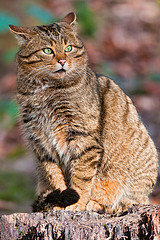Wild cat Habits
 Territory: wild cats usually hunt alone and lead solitary lives. The male marks out a territory of about 250 acres with urine, faeces and scratch-marks on trees; it has glands on its feet which secrete scent. Wild cats do not bury their droppings as domestic cats do.
Territory: wild cats usually hunt alone and lead solitary lives. The male marks out a territory of about 250 acres with urine, faeces and scratch-marks on trees; it has glands on its feet which secrete scent. Wild cats do not bury their droppings as domestic cats do.
The territory is fiercely defended from other males, especially if the male has a mate. It will leave its territory, however, to find a mate in early spring. If there is plenty of food, wild cats sometimes form groups to hunt their prey and to defend a territory from others.
Daily Life: the wildcat is a carnivore, hunting mainly at dawn and dusk; it either lies in ambush to pounce on its prey, or stalks it until fairly close and then rushes in to attack.
The day is usually spent resting. On a sunny day, a wild cat will bask on a tree branch or rocky outcrop where it can keep an eye on its surroundings. It may also have a den where there is a good view of the area around, either in a rock pile, under a tree stump or in an old fox earth or badger sett.
Breeding: wild cats mate in late February or early March. Courtship is very noisy with a lot of screeching, wailing and howling! Several males may call all through the night in an attempt to attract a female.
Gestation (the time during which the female is pregnant) lasts about 65 days. The female prepares a nest in a rocky cleft or hollow tree and gives birth to, on average, 4 kittens. The babies are blind at birth and open their eyes at about 10 days old. They are suckled by the mother for about 30 days and leave the den after 4 - 5 weeks. The kittens spend a lot of time playing and start learning to hunt with their mother from around 9 weeks old. The father takes no part in rearing his young. By 10 months of age, the kittens are almost fully grown but do not breed until the following year.
Even at a very young age, wild cat kittens are ferocious, spitting at, scratching and biting any intruders.
Normally, only one litter is born a year. Wild cats interbreed easily with feral cats (domestic cats that fend for themselves in the wild) and hybrids (the results of a cross between a wildcat and a feral cat) will often produce a second litter in late summer. Feral cats tend to revert to the tabby form and can cause confusion when identifying wild cats. Interbreeding may have caused an apparent reduction in size of wild cats during this century and not all wild cats are distinctively striped as a 'pure' wild cat should be.
Read More: Wild Cats and Humans